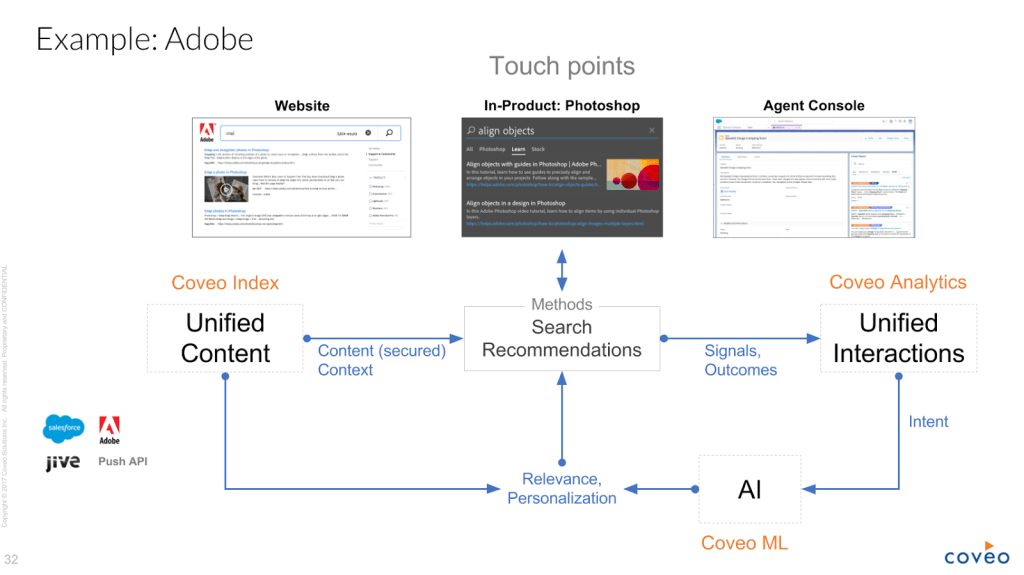The “one unified layer of relevance” will reign in 2018.
Welcome to 2018. The past year was one of exciting developments in enterprise search and machine learning, and I expect this year to be no different. Traditionally, I kick off my year with a list of predictions of how the field will change in the upcoming year to help our customers, partners and prospects understand how the market shifts will affect their strategy and tactics for the upcoming year.
This year will be a bit different, however, for my predictions. As I started to consider how enterprises need to plan for success in 2018, instead of developing a set of predictions, I realized it all came down to one prediction: the unified layer of relevance will revolutionize digital experiences in 2018.
What the Unified Layer of Relevance Means for Your Business
In the past, visiting a website, opening an email, using a mobile app and visiting a physical store were “silos” of interactions, with each interaction and the data it generated essentially separate from the others. Anyone who has had to go through page after page on a website after searching in a customer community or been frustrated with your contact center representative’s lack of knowledge on your issue understands how these “silos” lead to a disappointing experience. The same happens in almost every workplace: you’re using a collaboration app to work on a document while searching the intranet for relevant information, but because everything is separated into its own programs and data silos, the knowledge you need is just out of reach. Wasting time digging through file names, not having access to the knowledge of your coworkers – these are all symptoms of an eroding digital workplace.
For customers, these interactions are not separate. They are all part of one continuous information experience they have with your brand. Your in-store visitors use mobile phones to order an item online if it’s out of stock, check reviews of the item on the online community on the product, and even pull up the mobile app to find out how to install it, as your website visitors peruse your online community for troubleshooting before calling your contact center. With the unified layer of relevance connecting these interactions, the data follows your customers as they move between platforms and channels, delivering personalized content through every touchpoint with your brand.
The same goes for your employees. The relevance and sophistication of the tools they use as consumers are now expected in the workplace. Knowledge is the driver of your business, but these separate silos of interactions are limiting the ability of knowledge to power your workplace. Every interaction your employee has with the digital workplace, from a chat with a coworker to perusing company research, needs to be part of a relevant and personalized journey.
With the unified layer of relevance, every interaction informs the next interaction, no matter the platform or channel. If you are searching on a product documentation page for specific issue, then jump over to the website to keep looking, the website content is tailored to help you solve that specific issue. If you still cannot find the answer, and decide to place a phone call or chat to the call center, the agent console will automatically understand the issue that you are trying to solve and will see the relevant content in their knowledge base to help you solve it.
It sounds simple, but it’s revolutionary for your customers and employees. If you don’t have relevant information guiding them through every step of their journey, whatever their journey looks like, you are failing on your brand promise to deliver a superior experience.
How the Unified Layer of Relevance Works
It all starts with the cloud. After cloud computing really started to take off for the enterprise in the early 2000s, a whole new world of “big data” opened up. Now that data was relatively cheap to process, every enterprise saw big data as the ticket to more efficiency, productivity and greater revenue. They bought more and more enterprise cloud applications with those goals in mind.
A few years later, consumer tools advanced in terms of personalization and contextual awareness. Your smartphone knows enough about you to tell where exactly you need to be picked up, what shows you should watch, and what to buy for your next shopping trip. The bar was raised, but the data often doesn’t translate outside of its own silo, leading to a fragmented and frustrating experience.
This also created a problem of scale for many companies. Without artificial intelligence, personalized and relevant digital experiences must be created manually. Given all of the datapoints from different silos that go into your customer experience, this is a very time-consuming and difficult experience. Without a team of data scientists continuously analyzing your data (and having to add to that team considerably as your business grows), building a personalized and relevant experience is impossible.
The unified layer of relevance is the solution, and the companies who embrace it will reign supreme in 2018. Here is how it works:
Unify your content with an index. Rather than moving all of your data to a single system, use connectors that will automatically bring your data and content together into an index. Your connectors “feed” your index. This will break your data and content out of its silos, without having to go through a painful data migration project.
Apply artificial intelligence and machine learning. This is how you eliminate the scale problem. Rather than hiring and investing in an ever expanding team of data scientists, artificial intelligence will automatically analyze and apply the insights from your data to personalize experiences.
Feed your machine learning with interactions. Machine learning sits on top of your index, automatically understanding and digesting data from all of your data silos. Without connecting your data first, you will build a broken model that loses sight of the full picture of the experience your customer or employee is having. As your dataset grows, your system becomes more intelligent, delivering even more personalized experiences to your customers and employees.
Analyze your usage analytics. Machine learning does have its limits. It’s not able, for example, to create content or recommend content that doesn’t exist. This is where a powerful usage analytics, whether in Sitecore xDB or even your search solution itself, comes in. You need to continuously analyze where you have “content gaps,” or queries or recommendations that are not meeting your customers’ or employees’ needs. This empowers your team to create a strategy for your digital experiences that is completely data-driven.
Break your search out of the “search box.” The white box with a magnifying glass is not where your search ends. As more “emerging technologies become mainstream in 2018, with voice-integrated products, chatbots, virtual assistants, and more, they are all essentially creating search queries and personalizing experiences to the customers’ needs. The unified layer of relevance becomes even more important as customers expect these technologies to in some ways, perform tasks they would have taken on by themselves. That is a tall order for the level of personalization and intelligence expected – and one that only the unified layer of relevance, powered by machine learning, can meet.
Case study: Adobe
Adobe recognized the power that connecting the touchpoints their customers have with their product across channels could have for their customer experience. Rather than continuing to separate interactions into separate portals of the website, in-product help, and the call center, the company unified their context into a single index.
This allowed them to connect their touchpoints and share data between the different digital channels in one single unified layer of relevance. The customer’s search on the website informed the content that their agent saw when they called the call center with the same question. The customer’s behavior and context was crucial to personalizing the results and content they saw as they used the product. Predictive recommendations, based on users with similar context and behavior patterns, feed into the machine learning to personalize the interaction on each channel.

This revolutionized their customer experience. More and more companies will start to hear the frustration from their customers on how long it takes to find the right information, and how difficult their digital experiences are. They will even start to see it in lower customer retention rates, lower employee retention rates, higher onboarding costs, and higher customer support costs. As you look to 2018, think of how your business can embrace the unified layer of relevance. The organizations who do so will be looking forward to an exciting and innovative 2019 a year from now, as those who don’t struggle to play catch up and fail their brand promise.


